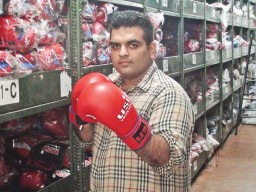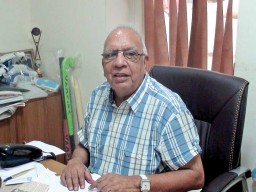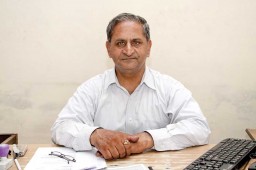 When Vijendar Singh won the bronze medal at Beijing Olympics 2008 there was hardly anyone who watched the match. Four years later at the recently concluded London Olympics 2012 when he lost in the quarter finals, there were millions sighing at his defeat. That is what has changed, and that is what is going to bring a positive change to the sports goods industry. With the Indian contingent performing satisfactorily both at the Commonwealth Games and the Olympics, Indian athletes and sports persons have achieved iconic stature, something that was until now the monopoly of cricketers. Sports have finally arrived as a culture in our country and there seems awareness towards cultivating players from the bud.Taking the lead from the same StitchWorld, in a series of interviews and discussions with Jalandhar and Meerut based manufacturers of football and boxing gloves, highlights the scenario both in the export and domestic market, and the China factor.
When Vijendar Singh won the bronze medal at Beijing Olympics 2008 there was hardly anyone who watched the match. Four years later at the recently concluded London Olympics 2012 when he lost in the quarter finals, there were millions sighing at his defeat. That is what has changed, and that is what is going to bring a positive change to the sports goods industry. With the Indian contingent performing satisfactorily both at the Commonwealth Games and the Olympics, Indian athletes and sports persons have achieved iconic stature, something that was until now the monopoly of cricketers. Sports have finally arrived as a culture in our country and there seems awareness towards cultivating players from the bud.Taking the lead from the same StitchWorld, in a series of interviews and discussions with Jalandhar and Meerut based manufacturers of football and boxing gloves, highlights the scenario both in the export and domestic market, and the China factor.
The Sports Authority of India (SAI) is working in collaboration with 321 training centres across the country including 58 self-governed centres, totalling to 14,900 residential and non-residential trainees. Adding to this there is a mushroom growth of privately-owned sports academies including the initiatives taken by sport celebrities like Vijendar Singh (Boxing), Virendar Sehwag, Suresh Raina, Anil Kumble, Bishen Singh Bedi (all Cricket), Baichung Bhutia (Football) and others who have either established or announced their academies for respective sports. Private sector giants like Tata have their football academy in Jamshedpur. Even famous English Premier League team Manchester United had come up with their training school in the country. Adding to this popularity is the latest trend which has recently come up in elections and political rallies, where footballs or other sports good are being used as promotional material. All of this is an optimistic sign for the market.
[bleft]Globally the sales of sports equipments, active apparels, and athletic footwears are valued at US $ 315 billion for year 2010.
The global sports goods and equipment market grew by 2.8% in 2011 to reach a value of US $ 64.9 billion.
The sports equipments market is forecast to reach a value of US $ 72.8 billion by 2016, an increase of 12.2% over 2011.
Data from NPD Group, Marketline[/bleft]
The Sports Goods industry plays a significant role in the Indian economy owing to both rural and urban employment potential, which makes the industry very important and the Government needs to provide a training centre for workers and a research and development centre for product development, besides adequate infrastructure to ensure growth of the segment. Presently, India has a minor share in world sports arena, a meagre percentage. However, with sports being a part of everyday lifestyle, this percentage converts into a respectable Rs. 600 crore business. The top items of exports were reported to be inflatable balls, hammocks, cricket equipment, boxing equipment and table tennis equipment.
The clusters around Meerut and Jalandhar are popular for manufacturing sports goods in the country capturing 90% of the total share of manufacturing happening in the country, divided almost equally between the two cities. In Meerut alone, there are about 1,250 registered and 2,000 unregistered large, medium and small sports goods manufacturing units providing direct and indirect employment to around 70,000 persons. Jalandhar too has thousands of enterprises giving employment to about 1,50,000 workers. Interestingly, there is a difference between the priorities of both the markets and their strategies and response in the face of present market conditions. While cricket equipment manufacturing dominates the Meerut manufacturing circle, the Jalandhar market majorly relies on the inflatable balls. However, both the cities have considerable number of companies working on different products.
[bleft]“Thinking of China as a competitor is naive. We at USI are very particular about our niche and therefore booked for next 6 months.” – Anurag Chaddha Director, Universal Sports India[/bleft]
The sports goods manufacturing clusters in India are a unique example of transplanted clusters and the industry’s roots can be traced back to Sialkot(Pakistan), from where post-partition numerous skilled artisans of Hindu origin migrated to India and finally settled in Jalandhar and Meerut. Then onwards, the industry branched out into products based on material used, some restricted themselves to wooden equipments like cricket bats, wickets or hockey sticks while the others turned towards what we call ‘soft leather manufacturing’ making cricket pads, hockey pads, gloves, etc. This was followed by companies specialising in a specific product category.
[bleft]“The domestic market is less susceptible to fluctuations. The export market does not show any signs of improvement for the next two years.” – Ramesh Kohli, MD, BAS[/bleft]
Most of the companies in the sports goods market maintain a balance between business in domestic and exports. However, Ramesh Kohli, MD of the Rs. 20 crore turnover BAS and a veteran in the industry,favours domestic over exports. “The export market is under pressure from the US and EU slowdown, which is showing no indication of improvement for the next two years, whereas the boom in the domestic market has been brought on by the changing perception of sports from a means of amusement to a fitness mantra,” says Kohli.
This positive change has increased the market size for domestic players. “We are fully focused on the Indian domestic market with around 1600 distributors and there is no ambition for exports as for now, as the domestic market has given us umpteen business, and we are selling up to 10,000 balls a day,” says Mohit Prabhakar, Senior Manager, Product Development at Nivia, Jalandhar, which solely deals in the domestic market.
Many companies are focusing equally on both markets with success. Jalandhar-based Universal Sports India has 55 years of experience in the industry and has been approved by the Indian Amateur Boxing Federation, as official suppliers of boxing equipment used in all domestic competitions. The major share of the company’s Rs.25 crore stop-line comes from exports as they manufacture equipments for brands like Everlast and Lonsdale. Meanwhile, the company is an established name in the domestic market with availability in more than 250 organised retail stores. Anurag Chadha, Director with the company is somewhat affected with the slowdown in the export market and says, “We are mainly doing exports, but we believe that the domestic market has huge potential in the coming times. In fact, Mary Kom’s bronze medal in boxing at the London Olympic 2012, may give a huge boost to the market.”
Kuldip Mahajan, Owner, Hind Sports another Meerut-based boxing glove manufacturer with an annual turnover of Rs. 4 crore is however happy with his exports to Europe and Middle East markets. “The export market for boxing gloves is doing well at present and the volume coming from the market is positive. The success mantra for Meerut industry lies in its ability to remain cost-effective as FOB for a pair of boxing glove ranges from US $10 to US $25,” he says.However, newly emerging markets such as Brazil are giving tough competition, besides facing a lot of competition from Pakistan and China.”
[bleft]Top importing countries (2004-05 to 2008-09): The top five destinations of exports of Indian sports goods were United Kingdom (Rs. 150.29 crore); United States of America (Rs. 132.84 crore); Australia (Rs. 83.17 crore); South Africa (Rs. 25.24 crore); and Germany (Rs. 25.16 crore) – [Data from Department of Industrial Policy and Promotion, Ministry of Commerce and Industry].[/bleft]
Football is the biggest category
Footballs as sport equipment is the largest segment of the global sports equipment market accounting for 23.7% (in terms of sales) of the market’s total value. China (US$ 455 million export in 2009), is the leading manufacturer of inflatable balls followed by Pakistan ($ 118 million) and Thailand ($ 59 million).
At present the manufacturing of football is being done in 3 ways. The first process is the one in which the entire ball is hand-stitched by a single operator at a time. The second is the one where sewing machines are involved in the stitching, sometimes with complete assembly line setup. The third and the most recent method of football manufacturing involve moulding of the panels instead of sewing them. However, football moulding is still not a prevalent practice in the industry and most of the manufacturing done involves sewing.
[bleft]“We are fully focused to the Indian market with around 1600 distributors. There is no ambition for exports as for now, domestic market has given us umpteen businesses, and we are selling up to 10,000 balls a day.” – Mohit Prabhakar Senior Manager, Product Development at Nivia[/bleft]
Unfortunately, India still sticks to hand sewing whereas China has majored into machine stitched balls. Footballs are made of different panel of PU/PVC/rubber material that are stitched together. Ideally, a football has 32 panels with a total of 910 stitches but the football may also be made of lesser number of panels.The entire process is similar to the manufacturing of apparels. The inflatable balls are generically divided into two categories, promotional balls and match balls.The parameters and manufacturing processes of both are distinctively different.
Of the total ball manufacturing business in the world, 90 per cent balls manufactured are for promotional activities with China leading the race by miles. “India is dawned with the responsibility of producing high-quality hand stitched match-balls due to absence of automation in the core processes of manufacturing,” says Rajan Mayor, MD, Mayor International, the oldest sports goods manufacturer of the country. Mayor Group has a factory in Jalandhar, producing around 10,000 balls every day through contractors working with around 2,500 households where each member produces 4 balls a day.
[bleft]Machine Stitched
A comparison of the growth of China’s inflatable ball manufacturing market with that of its closest competitor Pakistan (the leading hand-stitch football manufacturer clearly justifies the need of automation in this sports good sector. Pakistan has seen its share fall sharply (from 23.2% in 2004 to 13.2% in 2009) while China has experienced consistent growth (28.9% in 2004 to 50.5% in 2009).[/bleft]
Another pioneer, Sagar Bhalla, Director, Bhalla Sports which has been in the industry for 57 years and was one of the largest suppliers of footballs in the Commonwealth Games held in New Delhi in2010, claims, “Meerut is always known to produce quality rather than quantity and that’s why export market for sports goods in Meerut is thriving and factories are running to full capacity.”
Why compare between India and China…
Whatever the product, sports goods manufacturers agree that making comparison is foolhardy. Kiran Khinder, Director and Production Head of Rattan Brothers says, “There is a remarkable difference between the football being made here in India and the one being made in China. There is a difference in material, stitching quality and the overall durability of the product. That is why we are only doing promotional balls; we are hardly doing match balls. The underlining differentiator is the material availability and the lack of technology.”
Trying to match China’s competency has failed for many. “In order to compete with China in promotional ball manufacturing we have installed automated machines in our factory but due to the scarcity of skilled labour and absence of training institutes in the region, even the mechanisation failed. Also the thread used in the stitching of a football is an 8 ply thread which cannot be used in the machines we have due to its thickness and flat surface,”adds Mayor.
[bleft]“Success mantra for Meerut industry lies in its ability to remain cost-effective as FOB for a pair of boxing glove ranges from US $10 to US $25.” – Kuldip Mahajan Owner, Hind Sports[/bleft]
Anurag says that the case is the same for boxing gloves, yet he advocates a different approach. “Thinking of China as a competitor is naive. There is no chance for us to compete with them in terms of machine-based products; Indian industry had forever survived behind the skill of its labour. We only survive where the customer doesn’t need that big a quantity. If it is a lakh piece or mise, they go to China. If it’s 10-20,000 pieces, they come to us. We at USI are very particular about our niche and thankfully as an exception we are booked with orders for gloves for the next six months.” His company is sourcing most of its material (PU and PVC) from Taiwan.
[bleft]Footballs as sport equipment is the largest segment of the global sports equipment market accounting for 23.7% (in terms of sales) of the market’s total value. China (US $ 455 million export in 2009), is the leading manufacturer of inflatable balls followed by Pakistan (US $118 million) and Thailand (US $ 59 million).[/bleft]
Efforts to upgrade the manufacturing process are a direction for many. Anurag has tried breaking down the operations involved in the sewing of boxing gloves and take baby steps towards establishing an assembly line. Although, his experiment hasn’t brought much productivity as he has not been able to bring all the operations involved on to the line, and the product still follows the routine manufacturing process once the parts made in the line are done. That is exactly why the industry is desperate to implement technology and is looking for support from training institutes to help in the transition.
However, few have achieved success in mechanizing the sports good manufacturing process, as in the case of football at Nivia. “Even though we are still producing high quality footballs by hand stitching, there are big volumes of football being produced on sewing machines via proper assembly line,” informs Mohit. He does, however, concur with his counterparts when it comes to the scarcity of resources. “We still can’t produce the same quality on machine as through hand stitch. The reason lies with the fact that appropriate machines, that can stitch 3-4 layers of fabric or work with a 5-8 ply of thread, have not been identified,” reasons Mohit.
[bleft]“Meerut is always known to produce quality rather than quantity and that’s why export market for sports goods in Meerut is prospering.” – Sagar Bhalla Director, Bhalla Sports[/bleft]
China and the unavailability of material may be a few of the reasons for the current state of Indian sports industry, but they are not the only ones. Pakistan with its sport industry, 4 times the size of ours, is generating approximately US $ 450 million worth of business from the sports goods manufacturing industry. Kohli further highlights the deterrents in the sports good manufacturing industry. “There is an acute shortage of labour and also there is no regular supply of electricity,” he elaborates. Agreeing with Kohli, Anurag adds, “There has been a significant downfall in the younger generation showing interest to work as an operator. They prefer earning 5000 in an air-conditioned mall as security personal or as a doorman against 15,000 they could get after learning the skill.”
[bleft]“The difference between the football being made here in India and in China is in material, technology stitching quality and the overall durability.” – Kiran Khinder Director, Rattan Brothers[/bleft]
Just like apparels, sports good equipments also goes through testing standards. “Our balls go through shape warranty test, bounce test, air retention test. The testing is done by established testing organizations like SGS,” informs Kiran.Anurag adds, “There are federations for every sport, like IABA for boxing. They provide licensing and product approval.” For example, FIFA responsible for World Cup footballs has defined standard test for a soccer ball on the line of circumference, roundness, consistent rebound, water absorption, weight, pressure loss, size retention and balance. Boxing gloves also go through tests to check their weight (as boxing is fought in strict weight categories), colour fastness and strength. Similarly, there are British Standards for testing cricket protective equipments for strength. Garish Malhrotra, Technical Manager Hardware and Toys at SGS testing says, “All PPE (personal protective equipments) that are exported to Europe, need to pass CE certification.”
With the exception of cricket equipments, there has always been a question mark on the quality of sports products manufactured in India. However, Anurag disagrees with this generalization. “For our boxing gloves, we work with two markets: UK and Australia. UK buyers want quality and are ready to pay a higher price, while Australia is a price-sensitive market. We are successfully catering to both,” he avers.
Most of the companies complained about the state of the market and some even had alternative strategies. Both Rattan Brothers and USI are venturing into sportswear. “The aim is of course not to compete with the big players manufacturing for Nike and Adidas, but to export garments only to our existing product buyers,” clarifies Anurag.











